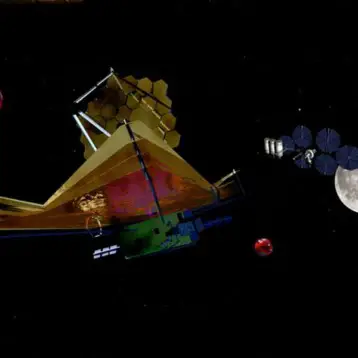|
A group of American scientists, including Arizona geophysicist Allen West, first presented the comet theory at the American Geophysical Union meeting in Mexico last year. According to this theory, a comet more than a mile in diameter exploded over earth nearly 13,000 years ago, causing a massive shock wave which in turn set off a series of explosions, each the equivalent of an atomic bomb blast. These explosions generated fires across most of the northern hemisphere.
This chain of events resulted in the destroying of primitive Stone Age cultures as well as the extinction of various animals such as mammoths and mastodons. It also prompted a 1,300 year period of climatic cooling, disrupting the development of emerging civilizations in Europe and Asia.
The theory stemmed from the finding of a layer of microscopic diamonds at 26 different locations in Canada, the United States, and Europe. The group claimed these diamonds were the remains of a large carbon rich comet that crashed into our planet 12,900 years ago.
New geological evidence found in Ohio and Indiana lends strong support to this theory. University of Cincinnati assistant professor of anthropology Ken Tankersley, working with Allen West and Indiana Geological Society research scientist Nelson R. Schaffer, has studied samples of diamond, gold, and silver from these areas. These samples have been traced, using x-ray diffractometry, to the diamond fields in Canada. The only plausible explanation as to how these samples could have migrated this far south is an explosion of the magnitude of a comet explosion. This is the strongest support yet of the comet theory.
|
Prior to this study it was suggested that the diamond, gold, and silver deposits arrived from the Great Lakes region by glaciers. Surprisingly, Tankersley entered this study intending to use these deposits as evidence opposing West’s theory. Upon hearing that West reached the conclusion that the comet exploded over Canada’s diamond bearing fields, Tankersley realized these deposits are indeed the strongest evidence in support of the comet theory.
Over the years various theories trying to explain the disappearance of the first Stone Age civilization in America, the extinction of mammoths, and the sudden cooling of the planet have surfaced. The latest findings offer a common cause for these events and may put to rest widely debated theories. As more data is gathered Tankersley, West, and Schaffer will be publishing their findings, which are another step in understanding the history of our planet.
Ken Tankersley can be seen in the documentary “Asteroids” airing on the National Geographic channel as part of their “Naked Science” series.
TFOT has recently reported on a theory about the near-extinction of the human race 70,000 years ago, and also covered a new method for the estimation of meteorite impacts, including the meteorite that was the trigger for the mass extinction of the dinosaurs. TFOT also covered the recent Peruvian meteorite and some new potential findings regarding the Tunguska meteorite as well as a new model showing that our solar system goes through the plane of the galaxy every 35-40 million years, accompanied by comets hurtling into the inner solar system, coinciding with mass life extinctions on Earth.
Further information on the recent findings can be found on the University of Cincinnati’s news website.
Top image: Comet (Credit: NASA).











